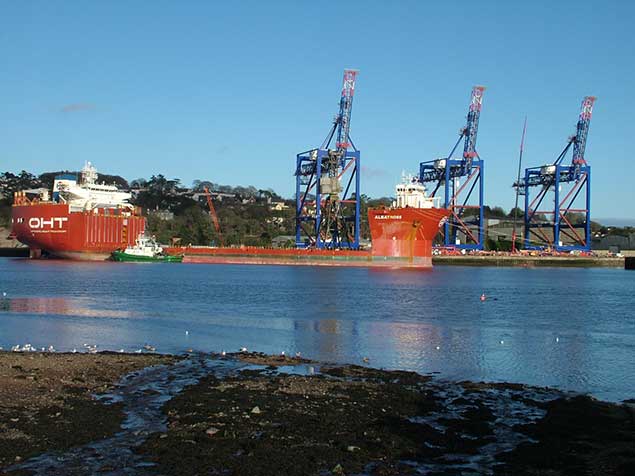Displaying items by tag: Cranes
‘Megamax’ Cranes From Cork Harbour Arrive in New York Area
Three huge cranes which left Cork Harbour at the end of August have arrived at their final destination the New York area, as RTÉ News reports.
Tom MacSweeney covered the three Limerick-built cranes upon their departure from Port of Cork on board the Big Lift Baffin for their transatlantic journey.
As our own Jehan Ashmore previously wrote, the three 150m ship-to-shore (STS) Liebherr cranes represent the largest single objects ever engineered in Ireland.
Ahoy! Take a look at the three new megamax ship to shore container cranes (STS), that recently made their journey from Cork to New York.
— Liebherr Maritime Cranes (@LH_Maritime) September 9, 2022
Stay tuned to see the first pictures from New York soon.#liebherr #shiptoshore #madeinireland #containerhandling #STS #ecoSTS pic.twitter.com/am41tSLC6E
Logistics for transporting the massive ‘megamax’ cranes were complicated by the presence of the Bayonne Bridge connecting New York and New Jersey, which has a clearance less than half that of their fully assembled height.
But the Big Lift successfully passed the bridge on schedule on Saturday afternoon (10 September) and the cranes will now be installed at Maher Terminals at Port Newark in New Jersey.
RTÉ News has more on the story HERE.
New Images Of Massive Cranes Loading Onto Ship In Cork Harbour
#CorkHarbour - The first of three Liebherr cranes has been loaded onto the Albatross heavy lift vessel at the Port of Cork.
As previously reported on Afloat.ie, the three 85-metre-tall cranes — each weighing more than 1,000 tonnes — are bound for Puerto Rico after being assembled from kit form at Cobh by employees from the Liebherr plan in Kerry.
Liebherr Marine has posted photos captured by drone as the first crane was loaded onto the specially adapted Albatross in Cork Harbour yesterday (Wednesday 22 February):
Three cranes, each weighing more than 1,000 tonnes and 85 metres high will be loaded on to a massive ship next week in Cork Harbour bound for Puerto Rico. It will be an amazing feat of engineering and an equally spectacular sight at the Port of Cork to see the massive cargo depart Roches Point.
The cranes have been asembled from kit form having first been shipped by sea from Fenit in County Kerry to the Doyle Shipping Group Terminal at Rushbrooke in Cork Harbour.
60 employees from the Liebherr crane plant in Kerry have been constructing the massive cranes prior to their transatlantic voyage.
The specially adapted ship, The Albatross from Holland, arrived yesterday into the Port of Cork awaiting its giant cargo alongside at Cork Dockyard, as the photo below shows. Known as a 'heavy lift' vessel, the Albatross is 264.45 metres long and 42.54 metres wide, the ship has a maximum speed of 9.5 knots.
 The heavy-lift ship, Albatross, is making maritime history in Cork Harbour this weekend having arrived at Cork Dockyard to transport three huge, fully-completed dock cranes to Puerto Rico Photo: Tom MacSweeney
The heavy-lift ship, Albatross, is making maritime history in Cork Harbour this weekend having arrived at Cork Dockyard to transport three huge, fully-completed dock cranes to Puerto Rico Photo: Tom MacSweeney
Tom MacSweeney in Cork Harbour adds: It is the first time that the Liebherr crane manufacturing company based at Killarney has exported fully-assembled cranes from Ireland for which they used the Cork Dockyard facility at Rushbrooke near Cobh to assemble them over the past few months.
The ship can automatically lie level alongside the dockyard quayside at all stages of the tide during the loading operation which is expected to take 4 to 5 days. Tracks will be laid to move the cranes onto the vessel.The Albatross will then move across Monkstown Bay to Ringaskiddy deepwater port where the cranes will be bolted to the ship and she will ballast for the voyage to Puerto Rico.






























































